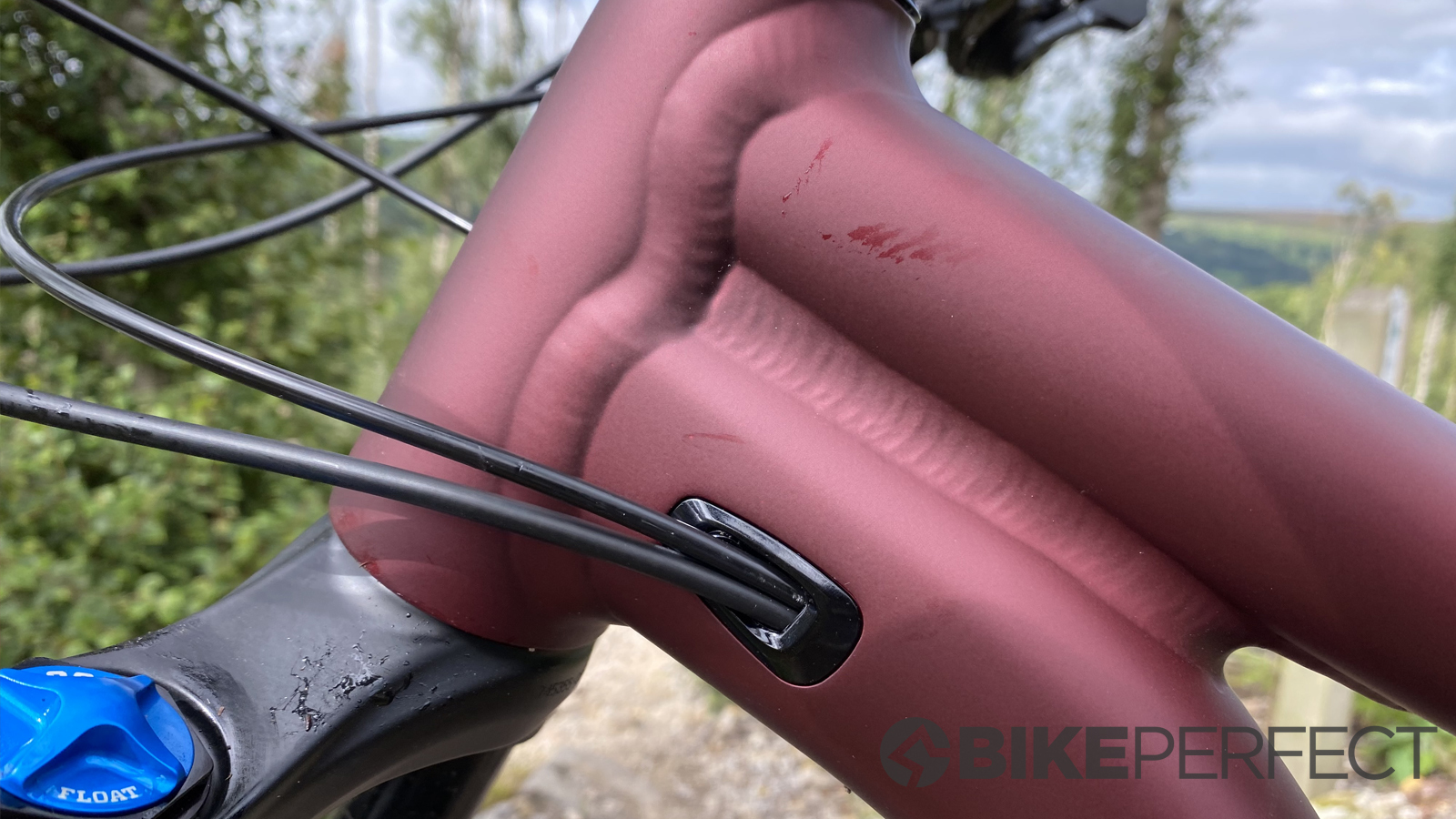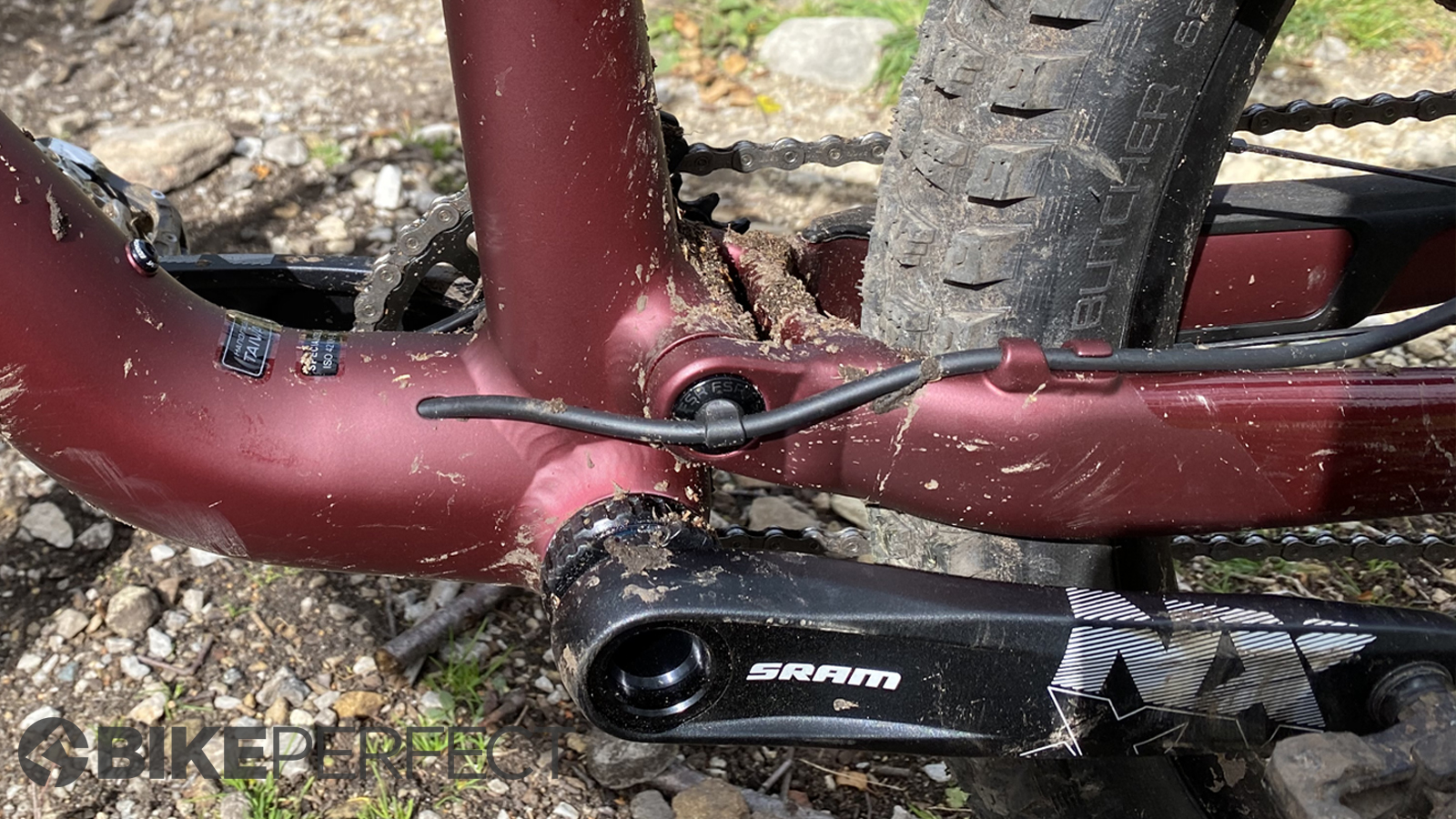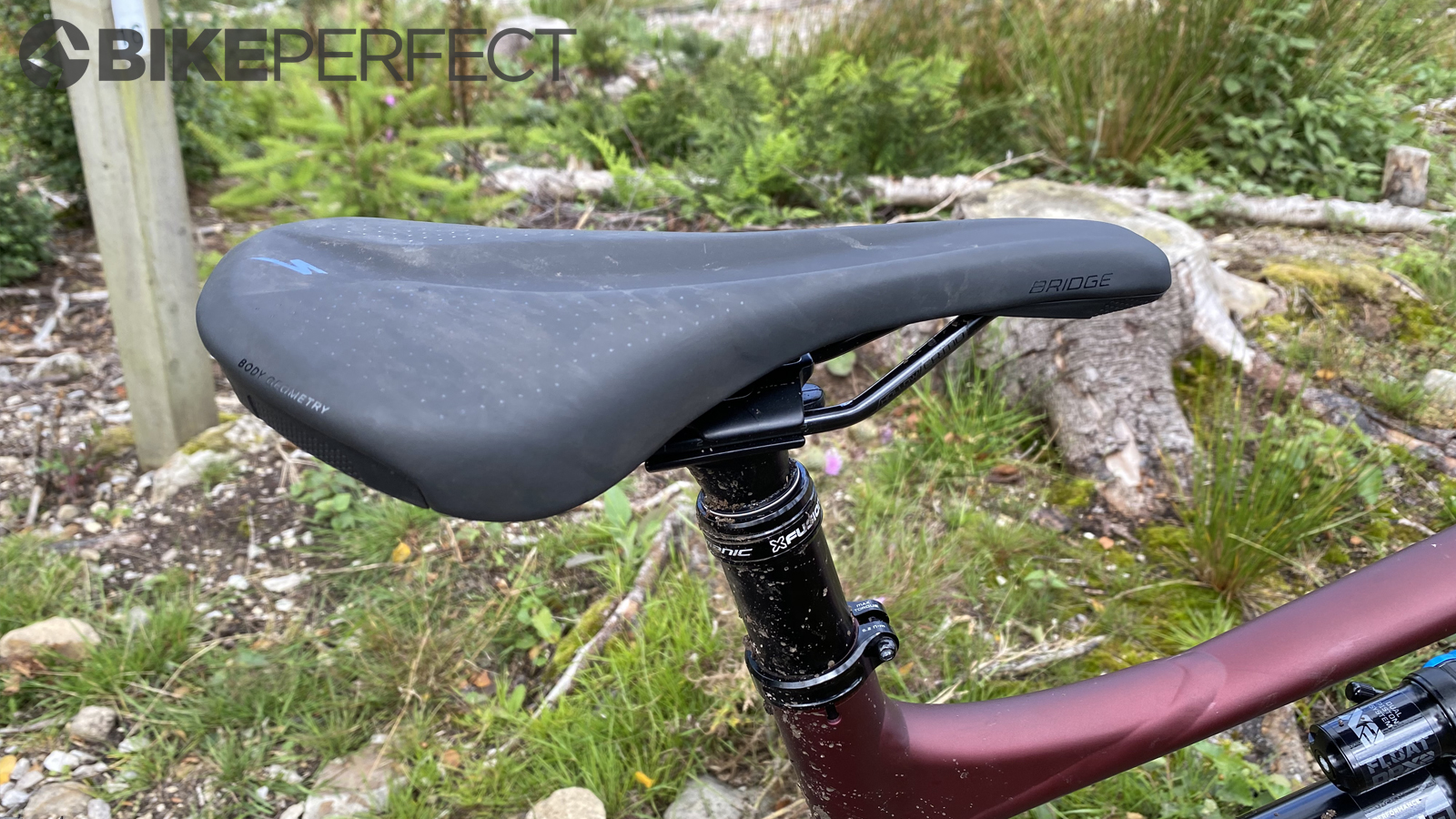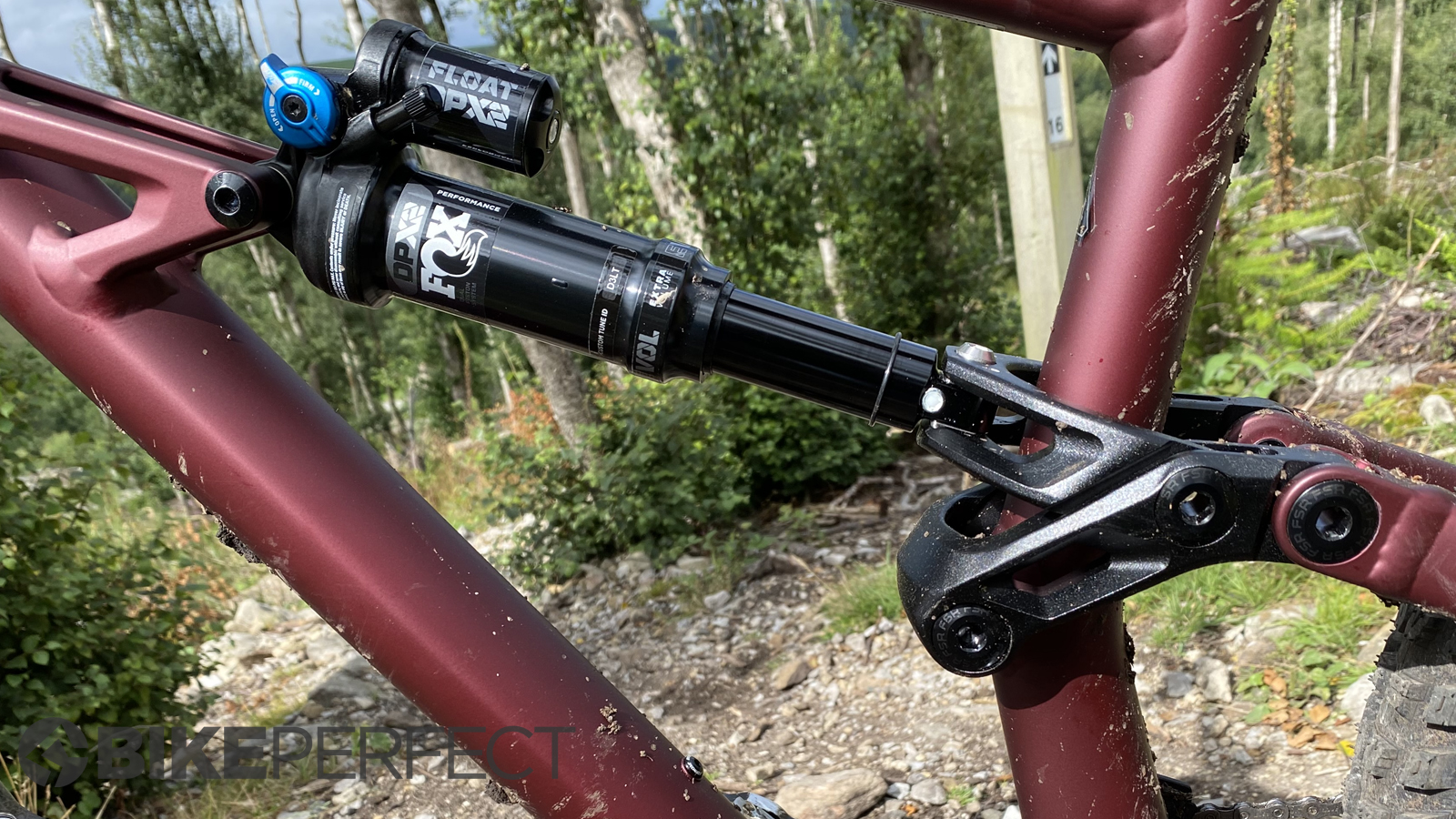Bike Perfect Verdict
Ridiculously confident yet riotously playful bargain priced bomber, with a brilliant mullet handling balance and sorted suspension. Only the feeble tyres stop it getting a five out of five
Pros
- +
Awesome 'Extreme Mullet' business/party handling balance
- +
Excellent suspension
- +
Great aggro kit spec (besides tires)
- +
Impressive value for a shop bike
- +
Neat details including gorgeous grips
- +
Room for big rubber
Cons
- -
Floppy tires lack cornering support
- -
Heavy
- -
Flick the shock into 'trail' mode for scything turns
- -
170mm cranks take a battering
Why trust BikePerfect
Status has been leaking out on the social media of Specialized’s raddest ambassadors for a while. The sorted 160mm suspension, cost-effective componentry and tidy M5 alloy frame create a great base for pushing hard too. It’s the super slack front but tight rear balance, mullet wheel combo and minimal branding style that give it a real edge though.
Best enduro mountain bike: carbon and alloy enduro mountain bikes for all skill sets
Best mountain bike tyres: all the top mountain bike tyres reviewed
Best mountain bike wheels: the best MTB wheels reviewed
Design and geometry
The full alloy frame keeps price reasonable but there’s some neat detailing including tight cable clamps for the internal routing, curved seat tube gusset for the low slung top tube and space for a bottle on the downtube. While the necks that join the offset main pivot are skinny, the belly of the chainstays is massive, likewise the seat stay junctions, and the horseshoe linkages onto the seat tube and the rear of the shock. A flippable shock mount chip lets you change geometry, there’s an ISCG mount on the screw in bottom bracket and the rear brake hose routing is particularly tidy thanks to an ’S-gate’ guide welded onto the chainstay. You get chain protectors top and bottom on the drive side and a small chain guide fitted as standard. The rear boost axle uses a fixed handle for tool-free wheel removal and there is masses of room around the rear tyre. It comes in two metallic color choices - maroon and charcoal - but the only Specialized branding is the S on the headtube and a small inset name on the chain guide and even the Status name only appears on the underside of the down tube.
Geometry is much more in your face with a super slack 63.2-degree head angle at the end of a 488mm reach on the S4 model we tested. Seat tubes are short for length so we could have gone up to the 512mm reach S5 size and still got the right saddle height with the 170mm stroke dropper post. S1 shrinks things down to a 417mm reach with a 400mm seat tube though so most riders will find a sorted fit which isn’t always guaranteed in affordable bikes.
The back ends are all the same at a super short 427mm though and BB drop changes from 8.5mm to 17.5mm (448 - 336mm BB height) depending on shock chip position. The chip also changes steering and seat (76 - 76.5-degree) angles by 0.5 degrees.


Components and build
The suspension is handled by Fox with a 160mm, 44mm short offset Float 36 Rhythm fork and a 230 x 60mm DPX2 Performance piggyback damper. Gearing is SRAM Eagle NX with an 11-50T cassette and 32T DUB chainset in 170mm arm length on all sizes. Brakes are SRAM Code R with 200mm rotors either end amplifying already impressive power. 800mm bar and 40mm stem (on all sizes) are Specialized (but the logo is tiny) while the multidirectional, soft compound ribbed grips are from Deity. Specialized provides the Body Geometry Bridge saddle and the smooth trigger-style remote for the super reliable X-Fusion Manic dropper post (150mm on S1 and S2, 170mm on S3, S4 and S5.)
The 29er front and 27.5in rear wheels use shallow, 30mm wide hookless alloy Roval (unbranded) rims ready taped for tubeless with valves in the ‘welcome pack’. 28 sturdy DT Swiss Industry spokes are laced into Boost hubs with a 10-degree ‘catch’ on the conventional splined freehub. Tires are Specialized Butcher with the Grid Trail casing, listed as 2.3in but actually 58mm (2.28in) at the front and 61mm (2.4in) at the back. Even with trail tires and carbon headset spacers it still comes in at a hefty 15.7kg without pedals.

Ride, handling and performance
With a head angle only 0.5 degrees steeper than Specialized’s Demo downhill bike but 22mm longer in reach (S4 sizes) with max leverage 800mm bars, the Status front end is hugely stable and stretched enough that it feels like you’re chasing a wheelbarrow down the trail at first. That gives you all the time in the world to deal with drama though and the 40mm stem and 44mm fork offset mean the steering still feels super light and responsive too. Even with treacherous tires (more on them later) means it laughs at sections that would normally have you nipping your O ring.
The super-short back end and different scrub rate/easier slide of the smaller wheel means it still feels surprisingly agile and responsive in slower, tighter situations. As the BMXers and Jibbers who’ve been leaking footage onto social have shown, it’s well up for jibbing and shredding, not just straight-line ploughing. Easy sag into the shock stroke also makes it much easier to loft the front wheel and float or manual than you’d expect too. That obviously compromises ultimate stability and rolling speed when you’re flat out in wide-open sections or battering through rocks. The smaller back wheel will also break out earlier than a 29er in loose/slippery conditions. But if getting silly and sideways is more important to you than podium positions then it’s a genuinely awesome balance of business at the front, party at the back that proves the mullet concept.
As well as the handling being in your face insolent, the Rhythm version of the 36 fork continues to give the finger to the more expensive members of the Fox family. The heavier, stiffer construction of the cheaper chassis gives it excellent tracking but with less arm fatigue on extended descents than the sharper, lighter 36s. The simple GRIP damper shows why it’s base tech has now spread up into Fox’s premium forks with awesome worry-free control way into the fear zone. The Sweep compression control and rebound adjust under the base of leg ‘bucket’ cover cope with a wide range of rider weight and aggression levels. Crucially the damping and air spring have enough forgiving bandwidth in each setting that they won’t punish the novice knob twiddlers or set and forget shredders who are going to be drawn to the price and rowdy promise of the Status.

After years of sending a shiver through us when we saw it on spec sheets, the recent base valve change and other tweaks on the DPX2 rear shock have made if far more controlled. Particularly in the kind of multiple, hard impact, high oil flow situations that the handling of the Status isn’t going to blink at. Specialized’s ‘RX Tune’ (light compression, medium rebound according to the ID label) is a great match for the faster reacting, shorter length, smaller rear wheel back end too. Even with relatively high rear tyre pressures to stop excessive crumple and fold and with synthetic end bushings, rather than a trunnion side mount, it still feels impressively sensitive off the top, with great traction to sideways action feedback through the gloriously-tactile Deity grips and large bore DUB axle cranks. Even with a large (0.85) volume spacer as standard, it does go a long way into the 60mm stroke without much provocation. That’s great for comfort/traction and rock/root ignorance but if you’re looking for a more predictable and solid platform for railing turns or pumping speed into your runs then we’d flick the low-speed compression adjust lever into the trail setting. Be prepared to do some dialling with the rebound knob too, as most of the extensive range of clicks don’t seem to do much. Again, that makes it far more forgiving if you don’t know what you’re really doing with those dials though, which is a far happier situation than the old DPX2 which would regularly reduce the most sentient suspension savants to tears at the trailside.
In terms of the rest of the kit, the relatively affordable NX Eagle won’t make you cry if you clobber it and can’t bend the steel cage back, but still gives you a 50 tooth crawler gear for self uplifting. The 32-tooth chainring is literally geared towards runaway train speed rather than an easy life on the climbs though, so the little chainguide offers useful peace of mind. 170mm long arms and easy shock sag mean cranks ends and pedals are going to take a battering on rocky terrain.
While they don’t have the luxury bearings or progressive power-boosting lever cam of top-tier Code brakes, the R brakes still have masses of clearly communicated power. The extra volume reservoir also improves their ability to cope with excess heat on extended descents in the same way as a piggyback reservoir on a rear shock.

The bars and stem are solid without stinging on drops or blowing up your arms on jackhammer descents and while we’ve never complained about Specialized grips, the Deity Knuckledusters are an absolutely delicious and very welcome indulgence on a bike where the budget has clearly been closely watched.
The suitably stealth wheels seem usefully forgiving without undermining the sorted control and precision of the bike and while the 10-degree pick up can cause out of corner gaps, it means pedal kickback is pretty much non-existent even on seismic drops or over sends that really justify the big volume shock spacer. As long as the cranks aren’t clattering the ground, the classic four-bar FSR kinematic means you can put the power down hard even on properly rough terrain without risking getting jacked over the bars so once you’re in motion the hefty mass of the Status is rarely an issue.
That leaves only one component that really needs replacing as soon as possible to fully unlock the potential of the Status. The tread pattern of the Butcher tyres is fine, the compound gives good wear rather than great grip and the relatively light construction means the Status is just a slow but surefooted tank on climbs rather than a straight-up ‘sod this I’m pushing’ dead weight. The tendency of the plasticky feeling Grid carcass to buckle even under relatively light cornering pressure, plus side knobs that seem determined to slam you into the dirt even faster than the carcass can fold up really has no place on a bike that’s half a degree off a downhill World Championship jersey. There’s also space for much bigger rubber than 2.3s too, so do yourself a favour, suck up the fact it’ll push overall weight over 16kg and get some proper bomber boots on there.


Verdict
So we hate the tyres, it’s not quite as straight-line fast as a twin 29er and it weighs a tonne. If you’re into cornering so hard you look like you’re having a stroke then you’ll probably want to run the eagerly mobile shock in trail too. Apart from that though, the Status is exactly what Specialized claim, it’s an absolute flat out, ragged edge riot that will look after new riders as well as providing a fantastic play platform for properly progressive riders. We wouldn’t be surprised to see it at the sharp end of enduro races under privateer racers with more skill than spend either.
Apart from the tyres, components, suspension - even contact points and small frame details are all excellent for the money and built for a long and brutal life. Specialized is renowned for its excellent customer service too, which when a bike begs you to ride as hard as the Status does is a very useful part of the package.
Test conditions
Temperature: 12-18 degrees
Surface: Natural DH trails and red/black grade DH runs
Tech Specs: Specialized Status
- Discipline: Enduro/DH
- Price: £2399
- Head angle: 63.2 degrees
- Frame material: M5 alloy mainframe and swingarm
- Size: S4 (Large)
- Weight: 15.7kg
- Wheel size: 29in front, 27.5in rear
- Suspension (front/rear): Fox 36 Rhythm 160mm travel, 44mm offset/Fox DPX2 Performance 230x60mm 160mm travel
- Components: SRAM NX Eagle 11-50T 12 speed gearing and shifter. 32T chainset. SRAM Code R brakes with 200mm rotors. Specialized Butcher Grid Trail 2.3in tires on Roval 30mm rims with DT Swiss Industry spokes and Boost hubs. Specialized 800x35mm bar and 40x35mm stem, X-Fusion Manic 170mm dropper post, Body Geometry Bridge saddle.

Guy Kesteven has been working on Bike Perfect since its launch in 2019. He started writing and testing for bike mags in 1996. Since then he’s written several million words about several thousand test bikes and a ridiculous amount of riding gear. He’s also penned a handful of bike-related books and he reviews MTBs over on YouTube.
Current rides: Cervelo ZFS-5, Specialized Chisel, custom Nicolai enduro tandem, Landescape/Swallow custom gravel tandem
Height: 180cm
Weight: 69kg

